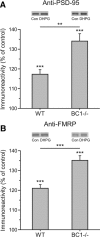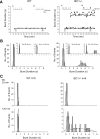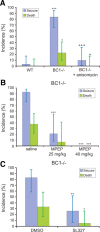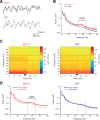BC1 regulation of metabotropic glutamate receptor-mediated neuronal excitability
- PMID: 19675232
- PMCID: PMC2866649
- DOI: 10.1523/JNEUROSCI.3893-08.2009
BC1 regulation of metabotropic glutamate receptor-mediated neuronal excitability
Abstract
Regulatory RNAs have been suggested to contribute to the control of gene expression in eukaryotes. Brain cytoplasmic (BC) RNAs are regulatory RNAs that control translation initiation. We now report that neuronal BC1 RNA plays an instrumental role in the protein-synthesis-dependent implementation of neuronal excitation-repression equilibria. BC1 repression counter-regulates translational stimulation resulting from synaptic activation of group I metabotropic glutamate receptors (mGluRs). Absence of BC1 RNA precipitates plasticity dysregulation in the form of neuronal hyperexcitability, elicited by group I mGluR-stimulated translation and signaled through the mitogen-activated protein kinase kinase/extracellular signal-regulated kinase pathway. Dysregulation of group I mGluR function in the absence of BC1 RNA gives rise to abnormal brain function. Cortical EEG recordings from freely moving BC1(-/-) animals show that group I mGluR-mediated oscillations in the gamma frequency range are significantly elevated. When subjected to sensory stimulation, these animals display an acute group I mGluR-dependent propensity for convulsive seizures. Inadequate RNA control in neurons is thus causally linked to heightened group I mGluR-stimulated translation, neuronal hyperexcitability, heightened gamma band oscillations, and epileptogenesis. These data highlight the significance of small RNA control in neuronal plasticity.
Figures






Similar articles
-
Dual regulation of fragile X mental retardation protein by group I metabotropic glutamate receptors controls translation-dependent epileptogenesis in the hippocampus.J Neurosci. 2011 Jan 12;31(2):725-34. doi: 10.1523/JNEUROSCI.2915-10.2011. J Neurosci. 2011. PMID: 21228181 Free PMC article.
-
Effects of regulatory BC1 RNA deletion on synaptic plasticity, learning, and memory.Learn Mem. 2017 Nov 15;24(12):646-649. doi: 10.1101/lm.045617.117. Print 2017 Dec. Learn Mem. 2017. PMID: 29142061 Free PMC article.
-
Regulatory BC1 RNA and the fragile X mental retardation protein: convergent functionality in brain.PLoS One. 2010 Nov 23;5(11):e15509. doi: 10.1371/journal.pone.0015509. PLoS One. 2010. PMID: 21124905 Free PMC article.
-
Protein translation in synaptic plasticity: mGluR-LTD, Fragile X.Curr Opin Neurobiol. 2009 Jun;19(3):319-26. doi: 10.1016/j.conb.2009.03.011. Epub 2009 May 4. Curr Opin Neurobiol. 2009. PMID: 19411173 Free PMC article. Review.
-
Do group I metabotropic glutamate receptors mediate LTD?Neurobiol Learn Mem. 2017 Feb;138:85-97. doi: 10.1016/j.nlm.2016.08.010. Epub 2016 Aug 18. Neurobiol Learn Mem. 2017. PMID: 27545442 Review.
Cited by
-
BC1 RNA motifs required for dendritic transport in vivo.Sci Rep. 2016 Jun 28;6:28300. doi: 10.1038/srep28300. Sci Rep. 2016. PMID: 27350115 Free PMC article.
-
Emerging roles of non-coding RNAs in brain evolution, development, plasticity and disease.Nat Rev Neurosci. 2012 Jul 20;13(8):528-41. doi: 10.1038/nrn3234. Nat Rev Neurosci. 2012. PMID: 22814587 Free PMC article. Review.
-
BC RNA Mislocalization in the Fragile X Premutation.eNeuro. 2018 Apr 19;5(2):ENEURO.0091-18.2018. doi: 10.1523/ENEURO.0091-18.2018. eCollection 2018 Mar-Apr. eNeuro. 2018. PMID: 29766042 Free PMC article.
-
Brain Long Noncoding RNAs: Multitask Regulators of Neuronal Differentiation and Function.Molecules. 2021 Jun 28;26(13):3951. doi: 10.3390/molecules26133951. Molecules. 2021. PMID: 34203457 Free PMC article. Review.
-
Regulatory BC1 RNA in cognitive control.Learn Mem. 2017 Jun 15;24(7):267-277. doi: 10.1101/lm.045427.117. Print 2017 Jul. Learn Mem. 2017. PMID: 28620074 Free PMC article.
References
-
- Atkins CM, Selcher JC, Petraitis JJ, Trzaskos JM, Sweatt JD. The MAPK cascade is required for mammalian associative learning. Nat Neurosci. 1998;1:602–609. - PubMed
-
- Barciszewski J, Erdmann VA, editors. Georgetown, TX: Landes Bioscience; 2003. Noncoding RNAs: molecular biology and molecular medicine.
-
- Bear MF, Huber KM, Warren ST. The mGluR theory of fragile X mental retardation. Trends Neurosci. 2004;27:370–377. - PubMed
-
- Brosius J. Waste not, want not: transcript excess in multicellular eukaryotes. Trends Genet. 2005;21:287–288. - PubMed
Publication types
MeSH terms
Substances
Grants and funding
LinkOut - more resources
Full Text Sources
Other Literature Sources
Molecular Biology Databases
